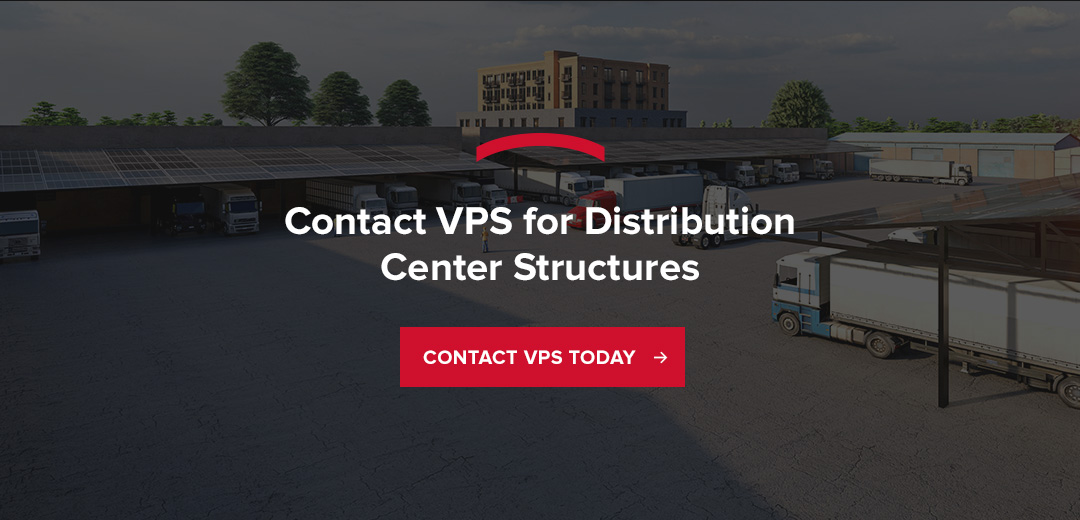How to Optimize Primary Warehouse Processes
03.13.23
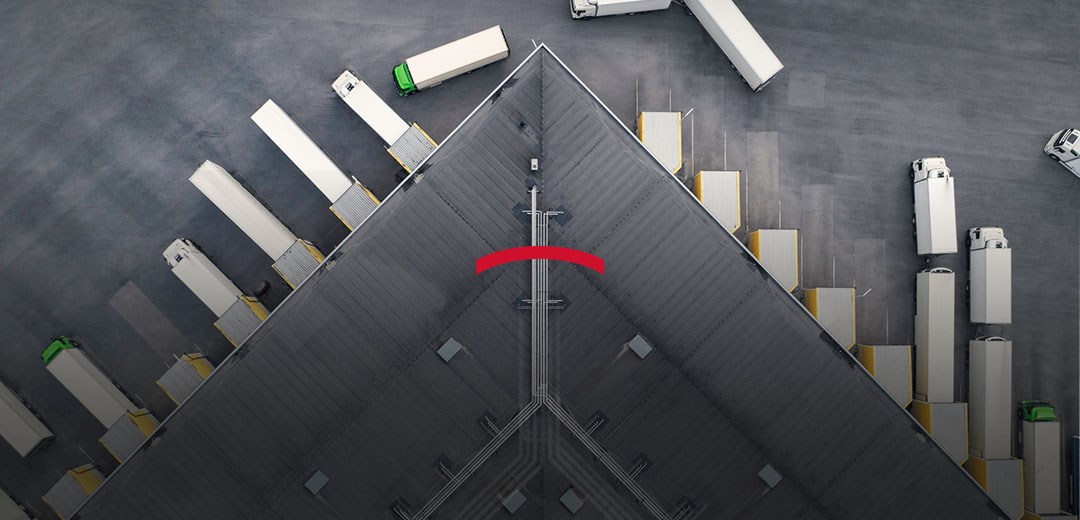
Distribution centers handle many critical processes, from the moment they receive a product to when they load it onto the delivery truck. These steps maintain each item’s safety and condition, help it reach the right customer, and — most importantly — ensure the recipient is happy with their purchase.
With such pivotal responsibilities, simplifying these processes is often necessary to improve efficiency, lower labor costs, and reduce the risk of error. In this article, we cover different warehouse processes and offer ways to optimize them.
What Are the Primary Warehouse Processes?
Distribution centers bustle with nonstop activity every day. Workers pack and label boxes, store items in their correct locations, and handle returned items from customers, to name just a few examples. But are there ways to simplify and speed up these labor-intensive tasks? Below are six key warehouse processes and how to improve them with different technologies.
1. Receiving
Receiving is the first stage and occurs when products arrive at the warehouse. The distribution center crew verifies each item, its quantity, and its condition. They must execute this process correctly and efficiently to ensure the following operations run smoothly.
Properly receiving merchandise involves filtering out damaged products to avoid liability. When the team receives an item, they are responsible for maintaining its quality until it leaves the facility. Software like advanced management systems (AMS) allows distribution centers to anticipate upcoming deliveries and assign workers accordingly. Power pallet trucks and conveyors enable faster cargo unloading to clear dock areas more efficiently.
2. Put-Away
The put-away process involves placing items in their proper locations until they’re ready for packaging and shipping. Storing items in the correct places makes tracking and tracing them easier, helps maintain product condition, and saves time during picking.
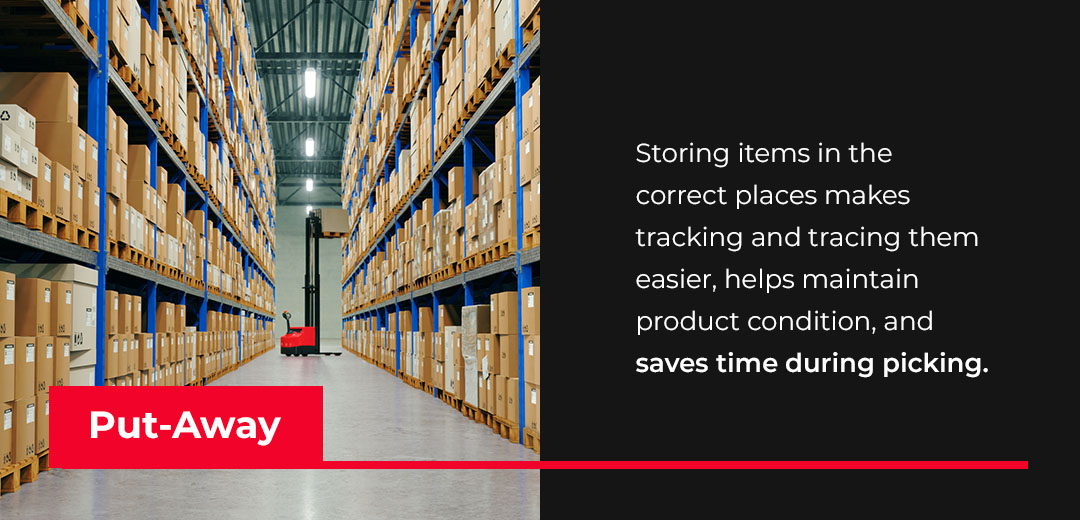
AMS software or mobile applications can automate the process of assigning appropriate storage locations. Appropriate locations help warehouses optimize their use of space and store items in a quick, effective manner.
3. Picking
Picking, the process of collecting products to fulfill customer orders, is one of the most crucial steps in warehousing. Streamlining this process helps distribution centers achieve higher accuracy, helping ensure better overall customer satisfaction.
Mobile and wearable technologies can improve this process, enabling workers to view picking lists wirelessly. They can scan the facility and access these systems in real time. Managers can also conduct an ABC analysis — ranking items where “A” is the most important and “C” is the lowest priority — to improve warehouse layout and simplify the picking process.
4. Packing
During packing, warehouse employees use proper packing materials and careful handling techniques to prepare picked items for shipping to the customers. They must package goods in a way that helps keep them safe, maintains their condition, and helps prevent damage.
Boxes must be lightweight and easy to lift and transport. Each order should include a sticker with a manufacturing code. Including unique codes allows distribution centers to trace products back to the systems, preventing misplacement and theft.
Specialized software can guide workers in these tasks to optimize the packing process. Workers enter key data into the packing system, such as product weight and dimensions. The system then automatically identifies the appropriate packing material type and amount, helping to lower packing costs and preserve each item’s safety.
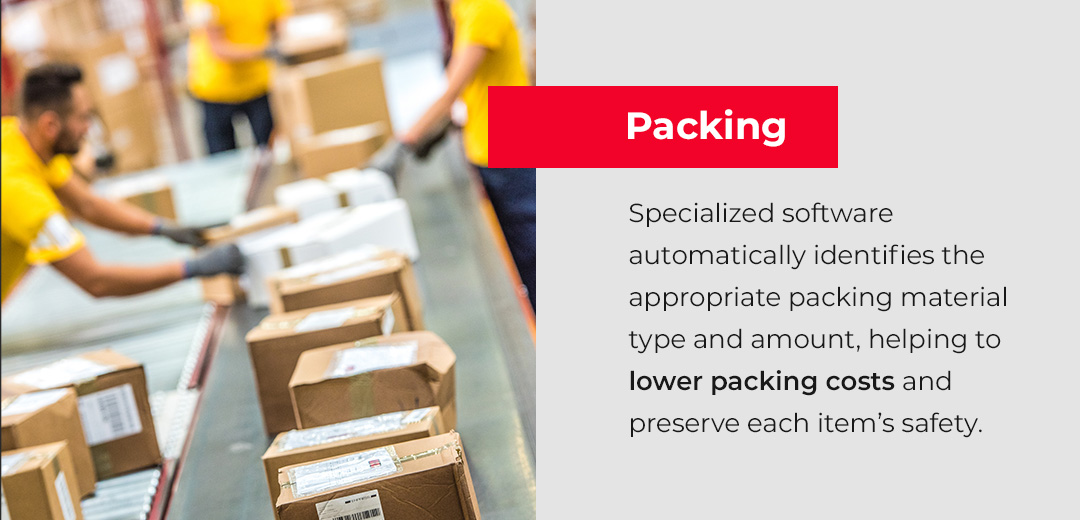
5. Dispatching and Shipping
Shipping involves sending the packaged product from the facility to the customer. Warehouse teams must ensure the item ships to the right customer, travels through the correct transit mode, and arrives safely and on time.
An effective labor management system (LMS) can help warehouses streamline dispatching and shipping tasks. They help workers distribute the proper types and quantities of products. A mobile shipping application gives them quick access to the necessary data, allowing them to verify shipments instantly. Additionally, advanced loading systems can instruct employees on loading products onto vehicles safely and efficiently.
6. Returns
If a customer is dissatisfied with their product and submits a return request, the warehouse must arrange to pick the item up. Distribution centers must prepare for these circumstances by designating facility space for returned items.
The facility must manually account for damaged products that they must discard. If the item remains in good condition, the staff can record it electronically and put it up for resale.
Online shopping is incredibly popular, as is the demand for returns. A quarter of all consumers return 5%-15% of the products they purchase online. This high return rate means distribution centers must develop a more advanced return process system.
It’s also necessary to keep a separate cost analysis system, accounting for extra return-related expenses like repairs, picking, and repacking. Specialized warehouse software can streamline return processes, reducing manual labor and human error.

Benefits of Updating Warehouse Processes
Revolutionizing primary warehouse processes offers several advantages. Let’s explore some of these benefits below.
1. Better Organization and Flow
Streamlining individual processes like packaging, picking, and storage improves overall operations. Executing each task manually can result in excess slow-moving products, costly errors, and a generally disorganized warehouse. Facilities can boost their workflow by implementing specialized software and optimizing storage space to increase capacity.
An organized distribution center makes it easier for workers to pick products, decreasing the time needed to fulfill orders. Furthermore, an organized warehouse can foster higher confidence in vendors when they tour these facilities, making them more likely to continue using its services.
2. Higher Productivity
Evaluating and adjusting their current workflow lets warehouses use their space better. Employee productivity will likely increase with a more comfortable and efficient work environment. Technology can streamline warehouse processes and make workers’ jobs easier to perform, helping them fulfill more orders in less time with less manual labor.
3. Cost Savings
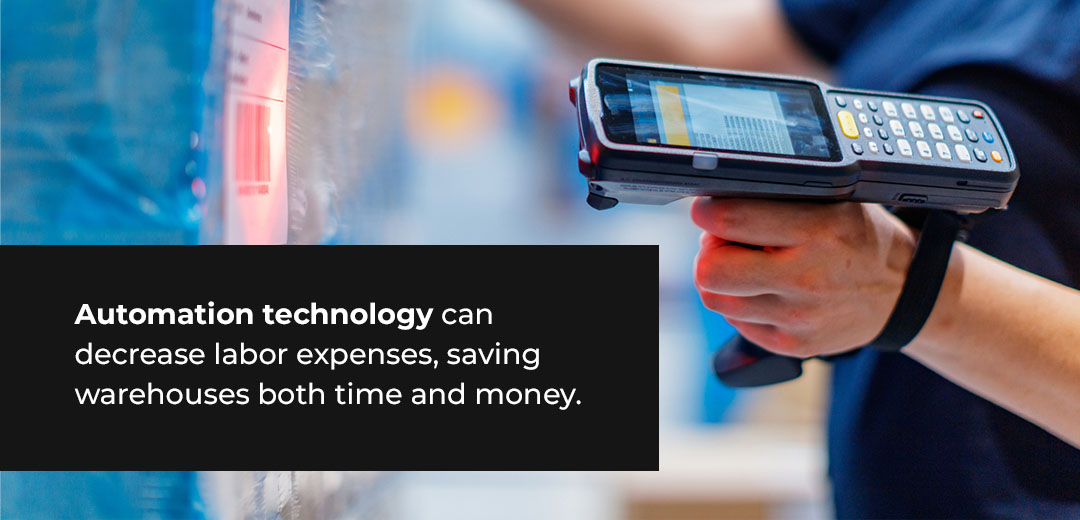
Increasing warehouse storage space and capacity reduces the need to invest in a larger facility. Ordering in bulk can save money with quantity-based discounts, and more storage opportunities allow distribution centers to order more products from vendors. Additionally, automation technology can decrease labor expenses, saving warehouses both time and money.
4. Improved Safety
Some of the most significant causes of injury in warehouse settings include the following:
- Slips, trips, and falls
- Pushing, pulling, lifting, and reaching
- Material handling
- Forklift incidents
Optimizing workflow and space usage can help mitigate existing safety risks. For example, more warehouse space creates separate traveling paths for pedestrians and forklift operators, lowering the risk of an accidental collision. With more room to perform their jobs, workers will likely face fewer injuries.
Tips for Optimizing Primary Warehouse Processes
Numerous technologies, software, practices, and strategies can improve warehouse operations. Below are six key tips for streamlining distribution center tasks.
1. Implement a Warehouse Management Software
As discussed above, warehouses perform many tasks that can benefit from automation, including receiving, picking, labeling, and packaging. Rather than trying to optimize each job individually, warehouse management software (WMS) provides a convenient platform for managing multiple tasks.
Some of these tasks include monitoring inventory quantity and location and assigning orders to different employees. Warehouse managers can oversee stock levels in real time, preventing unnecessary overhead and other stock control issues.
2. Consider Robotic Technology
Robotic solutions are a great way to increase efficiency and cut labor costs. Some examples include the following:
- Robotic arms: Automated robotic arms can move and lift heavy objects in warehouses, then place them onto pallets and racks. They can streamline repetitive receiving, picking, packing, and shipping tasks, reducing labor while improving accuracy. Robotic arms also reduce the need to perform tasks with a high risk of bodily injury.
- Drones: Drones can assist inventory management in distribution centers. They can retrieve and deliver items to warehouse workers. They can also fly around the facility, scanning items to see how many are in stock. Employees can then use this data to reorder items that are running low.
- Automated guided vehicles (AGVs): AGVs are portable robots that use marked lines or wires on floors, vision cameras, lasers, magnets, or radio waves for navigation. They can transport items between different points in warehouses without a human driver. They can accelerate the movement of heavy materials by traveling along a pre-designed circuit.
- Automated storage and retrieval systems (ASRS): These solutions use computer-based systems to place and retrieve products in different storage locations automatically. Warehouses frequently use them to replace large shelving areas, creating more floor space and boosting productivity.
Robotic technology can help reduce errors in warehouse processes, boost efficiency, and help fulfill orders faster, thus contributing to customer satisfaction.
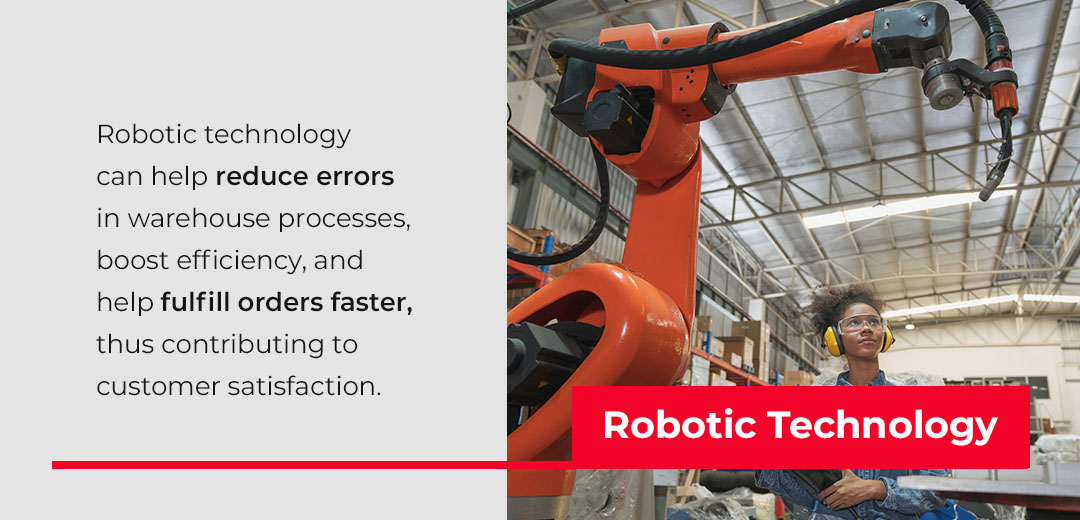
3. Understand Market Trends
Some items may receive the same level of demand all year. Others may see higher demand in specific seasons than others due to seasonal changes, economic cycles, and product trends.
Distribution centers should anticipate and prepare for these instances as much as possible. Following market trends and demand fluctuations can help them organize their operations, reduce excess inventory, and stock more of what they need to fulfill orders.
Demand forecasting software can help warehouses identify which items they’ll need to stock up on during certain seasons and which are in lower demand. They can then assign high-demand products to locations that enable easier access and picking. Additionally, solutions like ASRS, pallet flow rack systems, and forklifts can help boost efficiency, helping employees keep up with demand during busy seasons.
4. Enforce Safety Measures
Safer work conditions can positively impact warehouse operations. Here are some ways to promote safety in distribution centers:
- Prevent slips and falls: As mentioned above, slips and falls are common injuries in warehouse settings. Consider using equipment to reach high shelves, placing anti-slip mats over traffic lanes, and providing in-depth forklift safety training to prevent these incidents as much as possible.
- Use quality lighting: Never underestimate the power of a properly lit work area. Limited visibility can cause incidents during picking, sorting, and other primary warehouse processes. Sufficient lighting can promote safety and alertness, keeping staff aware of their surroundings.
- Perform regular inspections: Conducting visual warehouse inspections helps ensure operations are at peak safety and efficiency.
5. Organize and Audit the Warehouse
Just like a cluttered desk makes it difficult to perform an office job, a disorganized warehouse can reduce efficiency and set back operations. Products in incorrect locations, misapplied labels, and scattered boxes can lead to unwanted stress and chaos.
Physically organizing a warehouse is a helpful way to optimize the space. If managers and employees constantly notice cluttered floor spaces and congested aisles, it’s likely time for a layout redesign.
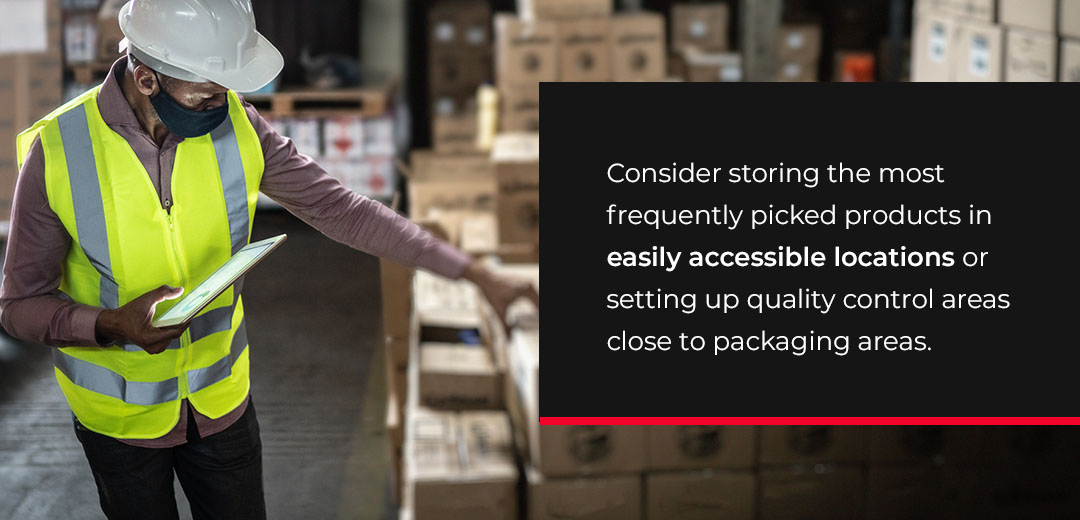
Consider storing the most frequently picked products in easily accessible locations or setting up quality control areas close to packaging areas. Use signage and labels to indicate travel routes and streamline navigation.
Even the simple act of clearing items away from primary foot traffic lanes and processing areas can make a substantial difference. After organizing the space, conducting a warehouse audit is an excellent next step. An audit can help managers see what products and materials are on hand, what they need more of, and how they can best use their storage systems.
6. Establish Business Goals and Key Performance Indicators
Aligning warehouse operations with business goals is a great way to improve optimization. Some specific goals might include:
- Enhancing customer satisfaction and sales.
- Reducing wasted time and increasing productivity.
- Implementing new technologies and methods that boost performance.
- Finding ways to automate repetitive tasks.
Warehouse managers should also establish key performance indicators (KPIs) to measure their progress toward achieving these goals. Some different KPIs might be:
- Order fulfillment times.
- Revenue growth.
- Employee or customer satisfaction ratings.
- Inventory accuracy.
- On-time deliveries.
How Shade Structures Can Help Improve Warehouse Processes
Warehouses and distribution centers looking to optimize their operations can invest in shade structures and loading dock canopies by VPS. These shelters are designed to defend staff, equipment, and products from outdoor elements such as hail, wind, snow, and sun. As a result, warehouse crews can carry out essential tasks and steps more efficiently, enhancing their everyday operations and workflow.
Explore the benefits of our commercial shade structures and how they can optimize distribution center processes.
1. Protects Products and Equipment
Several variables can pose risks to warehouse merchandise, vehicles, and other equipment. For example, trailers can reach up to 180 degrees Fahrenheit on summer days, putting drivers, vehicles, and the products inside them in harm’s way.
Fortunately, our distribution center shade structures can help prevent overheating in transport vehicles, lessening the risk of damage, burns, and injuries. These shelters can also prevent dangerous temperature increases, minimizing facility heat island effects. Our shade structures can reduce ambient air temperatures by as much as 30 F.
Our shade solutions can also protect equipment from other inclement weather conditions, helping preserve warehouse efficiency and output. We design and engineer our shade structures and loading dock canopies to withstand snow and wind and meet local building codes for these elements.
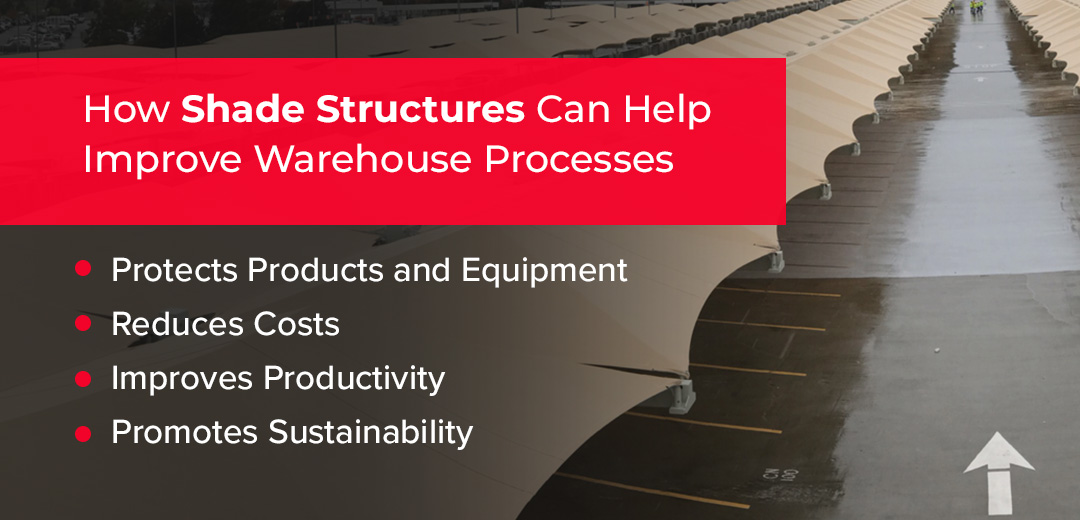
2. Reduces Costs
Hot, humid conditions can damage products, including clothing, furniture, electronics, and paper. By offering solid defense against UV rays, our shade shelters can help warehouse managers avoid the hassle and expense of replacing heat-damaged items.
Furthermore, we equip some of our structures with solar panels. These can help boost warehouse energy independence, minimizing costs associated with power grid electricity.
3. Improves Productivity
We manufacture our structures with durable, high-quality fabrics to ensure a long life span. Workers can load and unload more efficiently when they don’t have to readjust the shelter, helping streamline warehouse operations.
Reducing the risk of heat-related injuries and illnesses can also lead to fewer employee sick days, reducing productivity losses. Additionally, warehouses may lower worker turnover rates by providing safer and more comfortable working environments.
4. Promotes Sustainability
Environmental, social, and governance (ESG) scores evaluate businesses in their sustainable and ethical practices. A good ESG score indicates that a warehouse has made an effort to succeed in these areas.
Our distribution center shade structures can improve ESG scores. They highlight a facility’s commitment to safer, more sustainable operations through energy conservation and employee protection.
Commercial Shade Structures for Distribution Centers By VPS
VPS offers several shade and hail structures for warehouse managers to choose from. Each includes unique benefits and features so facilities can tailor a protective solution to their location, needs, warehouse dimensions, and design preferences.
Regardless of the chosen type, each structure offers weather and storm protection, heat defense, safety, and improved overall operations for equipment and staff alike. Below are the different distribution center structures we offer.
1. Cantilevers
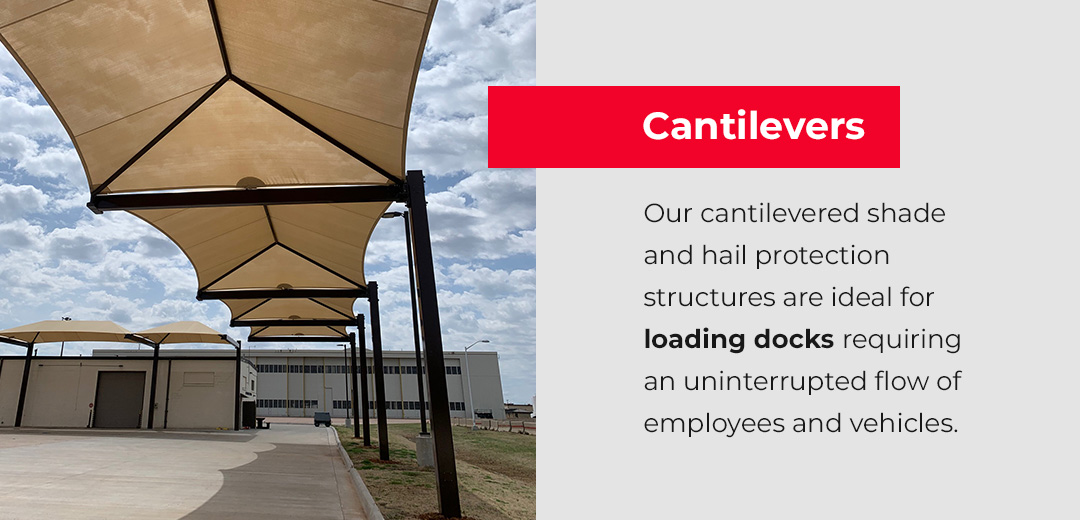
Our cantilevered shade and hail protection structures are ideal for loading docks requiring an uninterrupted flow of employees and vehicles. Forgoing traditional support braces and columns, these free-standing structures offer maximum space for parking, maneuverability, and navigation.
VPS cantilevers can defend vehicles, products, and workers from hail, heat, and other dangers. They also come in a variety of roof designs, allowing warehouse managers to achieve the visual aesthetic they desire for their property.
2. Covered Walkways
Our covered walkway structures can defend warehouse crews from harsh hail as they cross through outdoor areas. Hail storms often cause slippery surfaces, and our covered walkways can help keep these areas clear to lower the risk of slipping and falling.
3. Mass Coverage
VPS mass-coverage structures are suitable for large distribution centers that need significant hail defense. We design these shelters for large-scale parking applications and asset protection. Their modular package allows warehouse managers to accommodate their unique layout and terrain. They can easily find a mass-coverage structure that best meets their width and length specifications.
4. Solar Hail Protection
In addition to high-quality hail protection, our innovative solar panel-covered parking structures allow warehouses to reduce their energy expenses by harnessing solar power.
Businesses can decrease utility bills, raise ESG scores, and yield a considerable return on investment (ROI). Solar-covered parking provides many other long-term benefits for companies, including tax and electricity savings and durable vehicle coverage.
5. Solid Membrane
Our solid membrane hail structures use specialized fabric for maximum hail, snow, and sun protection. Our three-step process includes fabric patterning, welding, and attaching for the best possible coverage. Our fabric options — including HDPE, PTFE, and PVC — come in an array of colors, allowing warehouse managers to select their desired look.
We can fit many of our commercial hail and shade structures with membrane fabric, boosting overhead weather protection and safety. Investing in our solid membrane hail structures allows warehouses to enjoy excellent performance and aesthetics for many years.
Contact VPS for Distribution Center Structures
Protecting valuable company assets is a vital part of optimizing the workplace. Thanks to distribution center structures by VPS, warehouses don’t have to expose valuable equipment and employees to the elements or let vehicles bake in the sun for hours.
We’re devoted to providing warehouses and other organizations with the highest-quality weather defense. We’ve manufactured covered parking solutions for more than 120,000 vehicles and we represent over 95% of global automotive hail protection. Distribution centers can count on us for covered parking structures that meet their needs.
Contact VPS today to learn more about our solutions or request a free quote!
